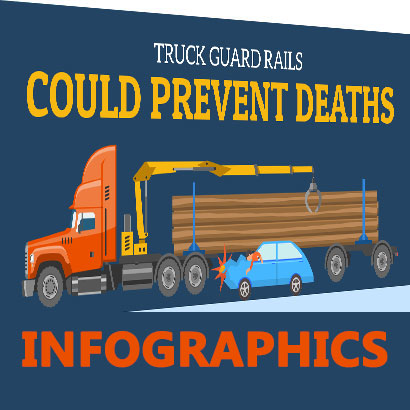Underride Guards, Underride Truck Accidents, and Taking Legal Action
 Unfortunately, current underride guard regulations have proven to be inefficient – something that is clear through the number of underride accidents that continue to happen. Were you involved in a truck accident that resulted in underride? Did you suffer critical injuries that have made it difficult to live a normal life? Did a member of your family experience a fatal underride accident? Regardless of being directly or indirectly affected by truck underride, you might have grounds to take legal action.
Do not hesitate to seek legal assistance as soon as possible. Our truck accident experts at Downtown L.A. Law Group are ready to represent you and help you fight for your right to file al claim. Contact us today.
Unfortunately, current underride guard regulations have proven to be inefficient – something that is clear through the number of underride accidents that continue to happen. Were you involved in a truck accident that resulted in underride? Did you suffer critical injuries that have made it difficult to live a normal life? Did a member of your family experience a fatal underride accident? Regardless of being directly or indirectly affected by truck underride, you might have grounds to take legal action.
Do not hesitate to seek legal assistance as soon as possible. Our truck accident experts at Downtown L.A. Law Group are ready to represent you and help you fight for your right to file al claim. Contact us today.
– Dangers of Underride make Truck Accidents Even More Devastating
– How to Prevent the Risk of Fatal Underride Truck Accidents
Quick Statistics Surrounding Truck Accidents and Underride Truck Accidents
In 2015, more than 4,000 people died in truck accidents. In 2017, there were more than 1,600 accidents associated with underride, including both rear underride and side underride. Within a twenty-year period ending in 2014, more than 1,500 people died due to side underride collisions alone. What do these numbers tell you? These numbers are just associated with fatalities – countless others have suffered permanent, life-altering injuries. Based on this quick overview of truck accident and underride statistics, it is clear that underride accidents are prominent.Federal Law Requires Rear-Guards to Lessen Instances of Underride
The current truck under guard regulations were signed into law in 1996. In 1998, the regulations were reinforced. Current truck under guard regulations include FMVSS No. 223 and FMVSS No. 224. FMVSS No. 223 is the equipment standard. The equipment standard establishes the requirements that the physical under guards must meet. It establishes strength requirements, testing procedures, and installation instructions for rear guards. FMVSS No. 224 is the vehicle standard. It determines which vehicles must be equipped with under guards. Specifically, it establishes that all commercial vehicles with weights of 10,000 pounds or more must be properly equipped with rear underride guards. This regulation also establishes the location in which the under guards must be installed on the rear of the trailers. Even with these regulations, however, underride accidents continue to happen. The constant recurrence of side underride has also made it clear that these requirements (which only apply to rear under guards) are outdated and inefficient in reducing underride as a whole. Considering that the number of side underride accidents are just as significant as the number of rear underride accidents, it makes no sense that truck under guard regulations ignore the need for side guards.
Attempts to change this have been visible through the Stop Underride Act. In 2017, the act failed. The act was reintroduced in 2019; however, there is uncertainty regarding whether the act will finally pass.
Even with these regulations, however, underride accidents continue to happen. The constant recurrence of side underride has also made it clear that these requirements (which only apply to rear under guards) are outdated and inefficient in reducing underride as a whole. Considering that the number of side underride accidents are just as significant as the number of rear underride accidents, it makes no sense that truck under guard regulations ignore the need for side guards.
Attempts to change this have been visible through the Stop Underride Act. In 2017, the act failed. The act was reintroduced in 2019; however, there is uncertainty regarding whether the act will finally pass.
Are Rear-Guards Inefficient?
Although the rear under guards installed on commercial vehicles meet the minimum requirements established by federal law, rear underride accidents continue to occur. In 2011, more than 250 people were killed strictly in rear underride truck accidents. Although many years have passed since this information has been available, rear under guard fatalities continue to be major issues. The purpose of underride guards is to prevent passenger vehicles from sliding underneath and becoming lodged under trailers in collisions. The steel bars that hang from the rear of trailers have, time and time again, proven to not completely prevent underride. In fact, the Insurance Institute for Highway Safety has conducted tests that prove that rear-under-guards are ineffective under certain circumstances. According to the tests conducted to check the efficiency of rear under guards, rear-guards are only effective in preventing underride when a passenger vehicle crashed straight into the center of the trailer. If the passenger vehicle hits either of the outer edges of the trailer, the rear-guards will fail to prevent underride. Without under guards, or without effective under guards, the passenger vehicle impacts the rear of the trailer at the windshield; this overpasses the vehicles structures (specifically crash/crumple zones) that are designed to absorb the energy of the collision, meaning that no vehicle safety features activate to prevent fatal injuries. What did the test show specifically? The Insurance Institute for Highway Safety crashed a Chevrolet Malibu (2010) into a parked commercial truck at approximately 35 miles per hour. The trailers used in the rear-guard test met all U.S. under guard standards; the trailers also met Canadian under guard standards, which are stricter than U.S. standards (require under guards to endure approximately twice as much force as that required by U.S. standards). There were eight trailers total. Crash dummies were also used to help determine the severity of the injuries suffered in the tests.Learn more about your legal options: call (855) 339-8879 to speak with a representative now.
There were three different types of collisions for the overall test:- Collisions in which the full width of the passenger vehicle hit the trailer
- Collisions in which 50% of the passenger vehicle’s width hit the trailer
- Collisions in which 30% of the passenger vehicle’s width hit the trailer
 In the test in which the car’s full width collided with the rear of the trailer, the rear-guards proved to be effective and prevented underride; the injuries sustained by the crash test dummies were non-life-threatening. In the tests in which 50% of the car’s width collided with the trailer, the majority of the rear-guards proved to be effective (only one rear-guard failed to prevent underride). In tests in which only 30% of the car’s width collided with the trailer, all but one of the rear-guards proved to be ineffective (only one instance resulted in no underride). In all instances in which the rear-guards failed to prevent underride, the head and neck injuries sustained by the crash dummy were so severe that they would represent fatal injuries for real-life victims.
This proves that vehicles that hit the back of trailers with anything less than the full-width of the car are more likely to result in underride. A collision at either of the far outer edges of trailers will result in less protection from underride. Considering that approximately half of all rear-end collisions involving trucks and passenger vehicles have an overlap of 50% or less (50% or less of the car’s width crashes with the rear of the trailer), underride is a constant possibility.
The result of these tests proved the inefficiency of rear under guards in preventing underride in truck accidents. This information has resulted in various attempts to regulate under guard requirements, to ensure that they are stronger and more likely to prevent underride. However, attempts have been largely unsuccessful. Truck guard regulations are still outdated and unsafe.
In the test in which the car’s full width collided with the rear of the trailer, the rear-guards proved to be effective and prevented underride; the injuries sustained by the crash test dummies were non-life-threatening. In the tests in which 50% of the car’s width collided with the trailer, the majority of the rear-guards proved to be effective (only one rear-guard failed to prevent underride). In tests in which only 30% of the car’s width collided with the trailer, all but one of the rear-guards proved to be ineffective (only one instance resulted in no underride). In all instances in which the rear-guards failed to prevent underride, the head and neck injuries sustained by the crash dummy were so severe that they would represent fatal injuries for real-life victims.
This proves that vehicles that hit the back of trailers with anything less than the full-width of the car are more likely to result in underride. A collision at either of the far outer edges of trailers will result in less protection from underride. Considering that approximately half of all rear-end collisions involving trucks and passenger vehicles have an overlap of 50% or less (50% or less of the car’s width crashes with the rear of the trailer), underride is a constant possibility.
The result of these tests proved the inefficiency of rear under guards in preventing underride in truck accidents. This information has resulted in various attempts to regulate under guard requirements, to ensure that they are stronger and more likely to prevent underride. However, attempts have been largely unsuccessful. Truck guard regulations are still outdated and unsafe.
Motions to Require Side-Guards on Commercial Vehicles
Currently, there are no regulations that require side under guards in commercial vehicles. This does not mean that there haven’t been any attempts to change this. The attempts to make these important changes have risen from a number of tests that reveal the true need for side under guards. The test revealed that AngelWing (a device attaching to the sides of trailers) effectively prevents underride in collisions at 40 miles per hour. Although these side under guard devices are available for purchase, there is nothing set in place to require trucks to be equipped with these devices. In one specific year with more than 1,500 underride crashes involving commercial trucks and passenger vehicles, more than 300 people died due to side underride. When compared directly to the approximate 290 people that died due to rear underride, this information is significant. People are dying due to side underride at a very similar rate to rear underride accidents. There is no real reason why the risk of fatal side underride accidents is not being addressed by the same federal regulations addressing rear underride accidents. If side guard regulations are implemented, the risk of underride accidents would significantly decrease in combination with updated rear guard regulations. Specifically, there were failed attempts to require side under guards and strengthen rear under guards in 2017. The act has been reintroduced in 2019. The Stop Underride Act (H.R. 1511) aims to strengthen regulations surrounding rear guards (to make them more effective) while also implementing side rear guards. The act doesn’t stop there – it also motions for front guards. The goal of the Stop Underride Act is to reduce the number of preventable harm (death and injuries) caused by underride. The act faced heavy opposition in 2017 and continues to face opposition in 2019. Specifically, the American Trucking Associations (ATA) and the Owner-Operator Independent Drivers Association (OOIDA) oppose these attempts. They claim that the requirements established in the Stop Underride Act are unrealistic. In other words, they claim that accommodating the under guard equipment would be close to impossible, since many trucks are physically incompatible with under guards. Overall, these associations believe that implementing new standards to commercial vehicles would be too costly and useless considering that many commercial vehicles are nearing retirement. The ATA and OOIDA, however, claim that they would support the act if new standards only applied to the manufacturing and introduction of new trailers in the industry. Although everyone seems to generally agree that truck under guards could save lives, disagreement lies in the way to implement these changes in a smooth way.
The ATA and OOIDA, however, claim that they would support the act if new standards only applied to the manufacturing and introduction of new trailers in the industry. Although everyone seems to generally agree that truck under guards could save lives, disagreement lies in the way to implement these changes in a smooth way.
Understanding Liability in Underride Truck Accidents: Could You Pursue a Claim?
Do you have the right to pursue a claim after truck underride resulted in critical injuries or death? For the majority of truck accident claims, liability typically falls onto the truck driver (sometimes onto the trucking company or employer of the driver). Liability is based on the fact that a specific party owes you a duty of care. For instance, truck drivers owe all other drivers a duty of care to drive safely and cautiously to avoid any accidents. Likewise, trucking companies have a duty to ensure that their drivers are being safe; they also have a duty to ensure that their vehicles are in safe condition. As explained, underride is not a new phenomenon. It is a common problem within the trucking industry. Trucking companies and truck owners, at minimum, have to ensure that their commercial trucks meet all minimum safety requirements – this includes under guard requirements. If rear underride occurs due to a lack of rear under guards or poorly installed rear under guards, for instance, a truck owner or a trucking company could be held accountable – specifically because they failed to address the risk of underride. If side underride occurs due to a lack of side under guards, the situation is different. It is easy to assume that truck owners and trucking companies do not have the duty to address the hazard of side underride with the appropriate guards because there is no regulation regarding the matter. However, since the danger of side underride is obvious (and supported by statistics), it is still possible for truck owners and trucking companies to be held liable – specifically for failing to address the risk of side underride on their commercial vehicles. If a truck owner or trucking company failed to address the well-known risk of underride due to the lack of under guard equipment on their commercial vehicles, they could be held accountable. What does that mean to you? This means that you might have grounds to pursue a claim – whether you suffered injuries or a member of your family lost his or her life. If the underride risk would have been addressed with the appropriate under guard equipment, the harm suffered would have likely been significantly less severe.Truck Underride and Product Liability
Under guard manufacturers have a specific duty, similarly to truck owners and trucking companies. They have the duty to ensure that their under guard equipment is safe for its intended use. This means that they have to do everything within their power to ensure that their under guard equipment is ready to take on collisions without failing to prevent underride, Under guard manufacturers have to subject their products to vigorous tests and inspections prior to making them available for truck owners and trucking companies to install on their commercial vehicles. When under guard manufacturers release their products with defects in design, labeling, or manufacturing, they could be held liable for the harm caused by underride incidents.Could You Recover Compensation?
You suffered traumatic injuries related to an under guard truck accident. A member of your family suffered fatal injuries in an underride truck accident. In any of these situations, could you be eligible to recover compensation? Could you recover compensation if you directly suffered harm? Could you recover compensation if you and your family indirectly suffered harm? Your right to recover compensation depends on the specific details of your claim. If you were in the accident and suffered a number of injuries, you could undeniably recover at least some sort of compensation. If a member of your family was killed in the accident, your right to recover compensation depends on your specific relation to the deceased. For instance, if you are an immediate family member to the deceased, such as a parent, child, or spouse, for example, you could recover compensation from a successful wrongful death claim.
How much compensation could you recover? What specific type of compensation could you be eligible to receive? The type of compensation that you might be eligible to receive depends on the specific details of your claim and can include some of the following:
Your right to recover compensation depends on the specific details of your claim. If you were in the accident and suffered a number of injuries, you could undeniably recover at least some sort of compensation. If a member of your family was killed in the accident, your right to recover compensation depends on your specific relation to the deceased. For instance, if you are an immediate family member to the deceased, such as a parent, child, or spouse, for example, you could recover compensation from a successful wrongful death claim.
How much compensation could you recover? What specific type of compensation could you be eligible to receive? The type of compensation that you might be eligible to receive depends on the specific details of your claim and can include some of the following:
- Medical expenses: for all medical bills resulted from the truck accident, including both costs for the treatment of injuries and costs for any life-saving attempts made to victims that eventually succumbed to their injuries.
- Lost wages: for all the lost income lost directly as a result of the harm caused by the accident, includes past and future lost wages.
- Pain and suffering: for all the mental and emotional distress associated with the traumatic truck underride accident.
- Loss of consortium: for the loss of the ability to have a normal, loving relationship with the victim as a direct result of the accident.
- Death services: for the expenses associated with death services, including funeral and burial services, necessary due to the victim’s death after the truck accident.
- Property damage: for the loss of personal property resulting from the truck accident
- Punitive damages: for punishment towards the defendant.
Understanding the Potential Value of Your Claim
 If you are interested in pursuing a claim after an underride truck accident, you might be interested in the potential value of your claim. How much is your claim worth? What might you be eligible to recover? The specific value of your claim is strictly based on the type of claim you are pursuing and the harm that you suffered.
In most cases, truck accident claims are directly affected by the type of injuries (or other harm suffered). In addition, truck accidents claims are generally valued much higher when victims sustain traumatic, life-altering injuries (or death) in comparison to mild to moderate injuries that might require just a few months to recover from.
If you are interested in pursuing a claim after an underride truck accident, you might be interested in the potential value of your claim. How much is your claim worth? What might you be eligible to recover? The specific value of your claim is strictly based on the type of claim you are pursuing and the harm that you suffered.
In most cases, truck accident claims are directly affected by the type of injuries (or other harm suffered). In addition, truck accidents claims are generally valued much higher when victims sustain traumatic, life-altering injuries (or death) in comparison to mild to moderate injuries that might require just a few months to recover from.
Learn more about your options for compensation by calling (855) 339-8879.
How much could your claim be worth? Consider the following points:- A woman was killed after crashing into a truck that was stopped on a highway. Although the truck was equipped with a rear-guard, there were faults in the guard’s design. Her fatal injuries resulted in a $1.2 million verdict against the manufacturer.
- A man was involved in a truck accident. The injuries sustained during the accident were so severe that the victim lost his life. The victim’s family pursued a wrongful death claim. They were awarded a $5 million settlement against the trucking company.
- A man was involved in a truck accident. He suffered a number of injuries, one of which included a cervical injury. The case settled for $1.4 million.
- A woman was involved in a truck accident after a truck failed to yield the right of way and turned in front of her. The woman’s vehicle crashed into the side of the truck. The woman suffered wrist, knee, and ankle injuries. The case settled for $1.2 million.
 If you would like to learn more about the potential value of your claim, do not hesitate to seek legal assistance as soon as possible. Discussing your claim with a knowledgeable attorney will help you gain a thorough understanding of the potential value of your claim and the settlement/verdict that you might be able to reach.
If you would like to learn more about the potential value of your claim, do not hesitate to seek legal assistance as soon as possible. Discussing your claim with a knowledgeable attorney will help you gain a thorough understanding of the potential value of your claim and the settlement/verdict that you might be able to reach.
What Should You Do after an Underride Truck Accident?
Most parties affected by any sort of personal injury accident agree that taking specific steps to prepare to file a claim is not the first thing that crosses their mind. Considering the fact that underride truck accidents are so devastating, it is not difficult to understand why following suggested steps is close to impossible. Even if you are unable to follow the recommended steps because you were not at the scene of the accident or because you were rushed to the hospital, there is still the possibility that you could reach a successful outcome; although, doing so might be more difficult. The suggested actions to take immediately after a truck accident (in general) include the following:- Photograph the scene of the truck accidents
- Photograph all physical injuries sustained
- Gather insurance information (and contact information) of all parties involved in the accident
- Contact the authorities and file an incident report
- Gather witness information
- Look for and take note of surveillance cameras that might have captured the incident
- Seek medical attention
- Report the incident to the appropriate insurance companies
Find out more about how we can help you. Call (855) 339-8879 to speak with a representative now.
Your Claim is Subject to a Deadline
Depending on the specific details of your truck underride accident claim, you might have grounds to file a claim against the party liable for the harm that you suffered. Unfortunately, you could lose your right to file a claim if you fail to take action within the appropriate length of time. All claims, including truck underride accident claims resulted in injuries or death, are subject to statutes of limitations. What is a statute of limitations? A statute of limitations determines the specific length of time that claimants have to pursue their claims. If claimants do not file their claims within the appropriate length of time, they will lose their right to sue. What statute of limitations applies to your claim? In the state of California, injury claims and wrongful death claims are both subject to a two-year statute of limitations. What does this mean? Whether you are pursuing a claim for critical injuries or wrongful death resulting from the underride truck accident, your claim will be subject to a strict two-year deadline. Depending on the specific details of your claim, exceptions to the statute of limitations could apply, leaving you with more time (and sometimes less time) to pursue your claim. Because failing to understand the deadline that could apply to your claim could lead to losing the right to sue, it is important that you discuss your claim with a lawyer and ensure that you have a thorough understanding of the statute of limitations that applies to your claim. The harm caused by underride truck accidents is one of the most devastating and traumatic for both victims and their families; do not allow a missing piece of information to prevent you from being able to pursue your claim.Contact Our Law Firm Immediately
Were you or your family directly harmed as a result of an underride truck accident? Underride can be avoided if trucks are properly equipped with under guard rails, which include rear-guards and side-guards. This means that the critical injuries sustained in the underride accident could have been avoided. If you or a member of your family suffered an underride truck accident, you might have grounds to take legal action – regardless of whether the incident resulted in critical injuries or in death. If you would like to explore the possibility of pursuing a truck accident claim specifically due to the underride that occurred due to the lack of under guards, do not hesitate to seek legal assistance with the experts at Downtown L.A. Law Group. Downtown L.A. Law Group is a personal injury law firm with many years of experience handling a variety of claims, including truck accident claims. Our experts are prepared to handle your truck underride claim and help you fight for your rights. Would you like to discuss your claim with the experts at our law firm? If so, it is important that you contact us and request to schedule a consultation or a second opinion. Our firm is dedicated to ensuring that all parties affected by any sort of accident have access to the legal assistance that they need to file a claim against the parties liable for their injuries. Unfortunately, many people fail to take legal action because they are afraid of the costs that are often associated with legal services. At Downtown L.A. Law Group, we ensure that you do not have to worry about any expensive fees for our legal services. To ensure that our clients have access to no-cost legal services, our law firm offers free consultations and free second opinions. During our free consultations and free second opinions, our lawyers will be available to answer all your questions and address all your concerns. Our experts will ensure that you have access to all the information necessary to either start or continue your claim. If you would like to benefit from our free consultations or free second opinions, do not hesitate to contact our law firm at your earliest convenience. Our free legal services are available as part of our Zero-Fee guarantee. Our Zero-Fee guarantee ensures that our clients never have to worry about paying any upfront legal fees for any of our legal services. Our law firm is also strictly based on contingency; therefore, our clients will never have to pay anything until reaching a successful outcome. If you are interested in discussing your truck underride claim with our experts, do not hesitate to contact our law firm today.Truck Guard Rails Could Prevent Deaths – Infographics

The Ultimate Guide to Truck accidents
– Truck Accident
– Truck Accident Questions: FAQ
– Common Causes of Truck Accidents
– Moving Truck Accident Attorney
– Fedex Truck Accident Attorney
– Who’s at Fault for Truck Accident
– Street Sweeper Accident
– Armored Truck Accident
– Cement Truck and Mixer Truck accident
– Detached Trailer Hitch Accident
– Injuries caused by Lift-gate Accidents
– Forklift Accident
– Injured in a Truck Accident
– Logging Truck Accident
– Garbage Truck Accident
– Food Service Truck Accident
– I Was Passenger in a Truck Accident
– California Truck Accident Laws
– Tow Truck Accident
– Invovled in a Truck Accident: What Should I Do?
– Postal Truck Accident
– Overloaded Truck Accident
– Santa Monica Truck Accident Attorney
– Animal Truck Hauling Accident
DTLA Client Review











